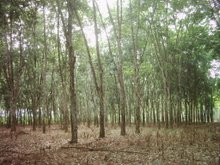Recently I visited my customer’s oil palm land in Yong Peng where he just completed his replanting.
While I walked in the field and noticed that the field full with “unfriendly” weed in this oil palm land. Asystasia is one of them and below photo is how this weed look like.
I abstract some information from “Common weeds of Malaysia and their control” by David E. Barnes & Luz G. Chan.
The weed is categorized under broadleaved weeds and usually planter called this weed as Asystasia (please bear in mind that the “A” of Asystasia should be in capital). However, if you give instruction to estate workers then you should named as “Akar ruas-ruas or Pengorak” (Malay name). The scientific name is Asystasia intrusa BI.
According to the writers, Asystasia has been distributed in Malaysia. Previously confined to South and central Johor (This statement is correct because Yong Peng in the central of Johor) but has spread to Negeri Sembilan, Selangor, West Pahang, Kedah and Kelantan. ( I will verify this statement when I travel to these states)
Usually the habitat of Asystasia in open situations especially during replanting periods such like my clients field.
This is what we means in open space where sunlight can penetrate to the ground surface and Asystasia love this kind of habitat. From this photo, you are also able to identify small spot white flower along the field road and there is Asystasia.
My client is no a professional planter and most the duty were carried out by the contractors with minimum supervision. I can categorized the field in poor management. Most planter aware that Asystasia is a prolific and competitive weed (above photo shows the evidence). It reported that dense growth was competitive to oil palm and removal of the weed resulted in 12% increase in fresh fruit bunch (FFB) production. Asystasia has high demand for nutrients particularly in N & P.
Method of control
1. The book recommend Dasatox F at 40ml (based on 18 litres spray solution). If no mistaken this product no available since I was a planter in year 1998. Usually we will use amine with 1-2mm of 18 litres spray solution. Please take note of this dosage is 1-2mm only. If you overdose the chemical, within a few hours, you are able to see the stem of Asystasia weed will blend down and subsequently dry off. Even this is fast action but your manager will jump on you because amine is a strong chemical which is harm to young palm especially just nearly planted. I can tell you the result because I tested before when I was a young planter.
How to identify the weed
The are 3 methods to identify this weed
1. Stem - soft, can grow to height of 100cm under favorable conditions
2. Leaves - opposite, often equal pairs, elliptical, rounded at the base
3. Inflorescence - terminal, numerous; single flower with small, narrow free sepals, creamy white, an indigo-blue patch on keel petal; corolla tube narrow, cylindrical, expanded above; stamens four in unequal pairs from corolla-tube, arched on the pistil.


















